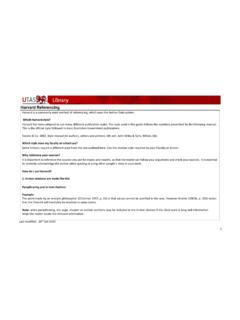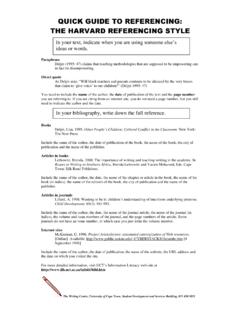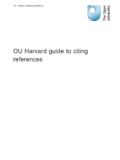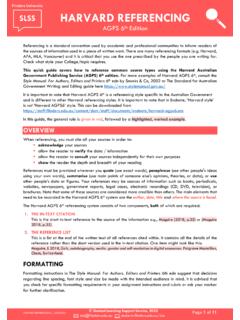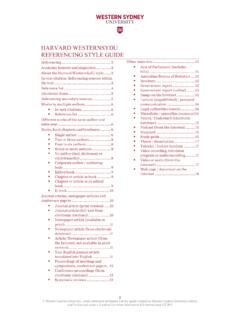Transcription of Harvard Referencing Style Guide - University College Dublin
1 November 2018 Harvard Referencing Style Harvard Referencing Style What is it? Academic writing requires authors to support their arguments with reference to other published work or experimental results/findings. A reference system will perform three essential tasks: Enable you to acknowledge other authors ideas (avoid plagiarism). Enable a reader to quickly locate the source of the material you refer to so they can consult it if they wish. Indicate to the reader the scope and depth of your research. The Harvard Style is a widely used Referencing system to help you achieve these objectives. How do I use the Harvard Referencing Style ? The Harvard Style involves two tasks: How you refer to other authors in the body of your text (in-text citation).
2 How you compile a list of reference sources at the end of your text (reference list). What does it look like? Here is an extract showing what in-text citations look like in the Harvard Style (Where you are not quoting another s specific ideas or exact words. See the next page for these.) It has been claimed that due to funding being almost exclusively available from the Irish Film Board (IFB), Irish film makers are restricted to the type of Ireland they can depict in their work (MacDougall, 2009). Jervir (2011) argues that subjects such as Northern Ireland are disproportionately represented as these are key areas of interest to the IFB. Here is an example of what a Reference List looks like in the Harvard Style Hayes, B. C., McAllister, I.
3 And Dowds, L. (2011) 'Depicting Ireland on film, what are we really saying?', Social Cinema Journal, 54(4), pp. 454-482. Jervir, C. E. O. (2010) 'Symbolic violence, resistance and how we view ourselves in Irish Film', World Cinema, 37(6), pp. 392-407. MacDougall, H. (2009) 'Who needs hollywood?: The role of popular genre films in Irish national cinema', The Canadian Journal of Irish Studies, 35(1), pp. 39-46. Moriarty, D. (2012) Funding models for Irish film makers. Dublin : Collins Press. Quotation Quoting ideas If you are including the ideas of another person from a specific page range or page in a source, rather than direct quotation, Harvard also requires you to include a page number. Your quote would look something like this In the review it was noted that research shows open plan office spaces damage workers' attention span, creativity and satisfaction (Davis et al.)
4 , 2011, p. 22). If you are unclear as to when to include a page number when quoting ideas, discuss this with your lecturer or tutor. Bring along examples to show them. The Harvard Style dictates that when using another's exact words, known as direct quotation, then those words must be placed in inverted commas/quotation marks ('' or "") followed by an in-text citation that includes the Author Last name, Year and page numbers. Inverted commas/quotation marks can be single or double, simply be consistent or check with your lecturer/school. See our two examples below. Short quotations Short quotations are generally held to be two or three lines in length. An example of a short direct quotation would be It was reported that 'findings show children have a high level of enjoyment, while exercising with the system as indicated by the positive responses to all three questions' (Fitzgerald et al.
5 , 2008, p. 66). Long quotations Long quotations are generally held to be longer than three lines. These are laid out in a separate paragraph of text and indented. No inverted commas/quotation marks are included. An example of a long quotation would be In their research on rehabilitation using Wobbleballs, Fitzgerald and her team conclude that: The fourth question collected some feedback from children and while most provided positive comments a small number of children (n=13) mentioned that the wobble board was difficult to control or hard to use . We must therefore investigate some easier methods to control the game as an option for some children. Future research is needed to investigate the benefits of the system as an exercise intervention for children and to examine how training using Wobbleball could be integrated into the existing physical education curriculum in schools.
6 (Fitzgerald et al., 2008, p. 66) In this Guide we show how common reference types should look in your reference list (Reference) along with an example. Immediately following this will be two samples of how that reference should appear as an In-Text-Citation. If the exact reference type you are looking for is not shown in this Guide , look for one similar and follow the same rules. Alternatively consult the book Cite them Right, by Richard Pears and Graham Shields which is available in UCD Library. Book with one author Reference: Author/Editor Last name, Initials. (Year) Title. Edition. Place of publication: Publisher. Example: Example: McLeskey, J. (2013) Inclusion: effective practice for all students? 2nd edn. London: Pearson.
7 In-Text-Citation: Author Last name (Year) (Author Last name, Year) Example: According to McLeskey (2013) As has been argued (McLeskey, 2013) Book with two or three authors Reference: First author Last name, Initials, second author Last name, Initials and third author Last name, Initials (Year) Title. Place of publication: Publisher. Example: Shalloway, A., Murphy T. and Trott, J. (2001) Design patterns explained: a new perspective on object-oriented design. London: Addison Wesley. In-Text-Citation: First author Last name, Second author Last name and third author Last name (Year) (First author Last name, Second author Last name and third author Last name, Year) Example: Shalloway, Murphy and Trott (2001) suggest It has been suggested (Shalloway, Murphy and Trott, 2001) Book with four or more authors Reference: First Author s Last name, Initials et al.
8 (Year) Title. Place of publication: Publishing company. Example: McGeady, et al. (2006) Veterinary embryology. Oxford: Blackwell. In-Text-Citation: First author Last name et al. (Year) (First author Last name et al. Year) Example: McGeady et al. (2006) It has been suggested (McGeady et al., 2006).. Book with a corporate author Reference: Name of corporate author (Year) Title. Place of publication: Publisher. Example: Department of Agriculture, Food and Rural Development (2000) Pedigree sheep breed improvement programme: performance results for lambs summer 2000. Cavan: Department of Agriculture, Food and Rural Development. In-Text-Citation: Name of corporate author (Year) (Name of corporate author, Year) Example: Figures from the Department of Agriculture (2000) show Figures from other sources (Department of Agriculture, 2000) Book with an editor Reference: Editor(s) Last name, Initials (ed.)
9 (Year) Title. Place of publication: Publisher. Example: O'Riordan, T. (ed.) (2001) Globalism, localism and identity. London: Earthscan. In-Text-Citation: Editor s Last name (Year) (Editor s Last name, Year) Example: This was examined in O Riordain (2001).. Others have examined this claim (O Riordain, 2001).. Chapter in an edited book Reference: Chapter Author(s) Last name, Initials. (Year) 'Chapter title', in Editor's(s) last name, Initials. (eds.) Book title. Place of publication: Publisher, page range. Example: Rose, H. (2000) 'Risk, trust and scepticism in the age of the new genetics', in Adam, B. et al. (eds.) Risk Society and Beyond. London: Sage, pp. 77-80. In-Text-Citation: Author(s) Last name (Year) (Author(s) Last name, Year Example: This was proposed by Rose (2000).)
10 It has been proposed (Rose, 2000).. Electronic Book (e-Book) Reference: Authors Last name, Initials. (Year) Title of book. Available at: URL (Downloaded: Day Month Year). Example: Luhr, W. (2004) The Coen brothers' Fargo. Cambridge University Press film handbooks series. Available at: ebook/dp/B001G60 IQI/ref=kinw_dp_ke (Downloaded: 24 February 2014). In-Text-Citation: Author s Last name (year) (Author s Last name, year) Example: Luhr (2012) suggests that the Coen It has been argued that The Coen brothers represent a revolution in cinematography (Luhr, 2012, Chapter 2, 22%). Translated Ancient Texts Reference: Author Last name, Initials. (Year). Title. Translated by (if relevant). Edition (if beyond 1st Edition).
